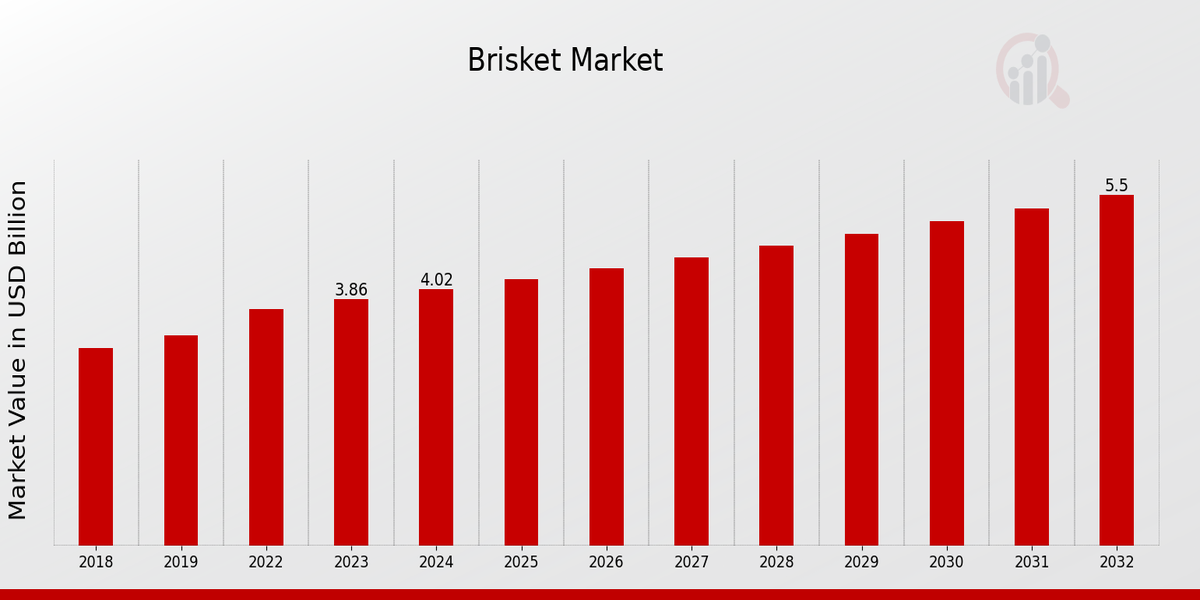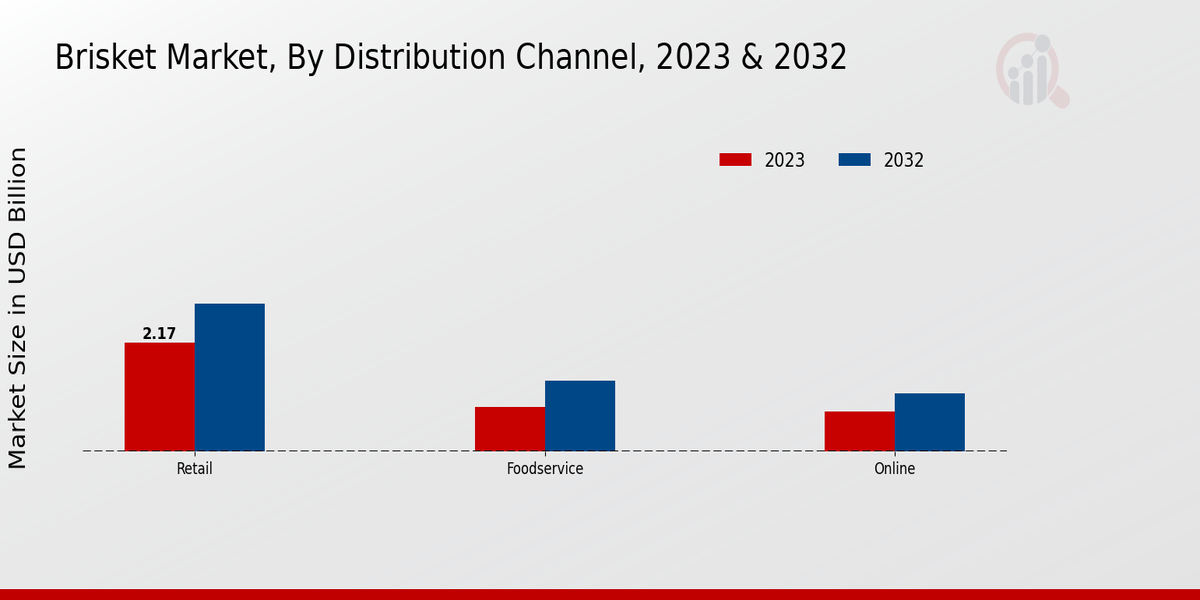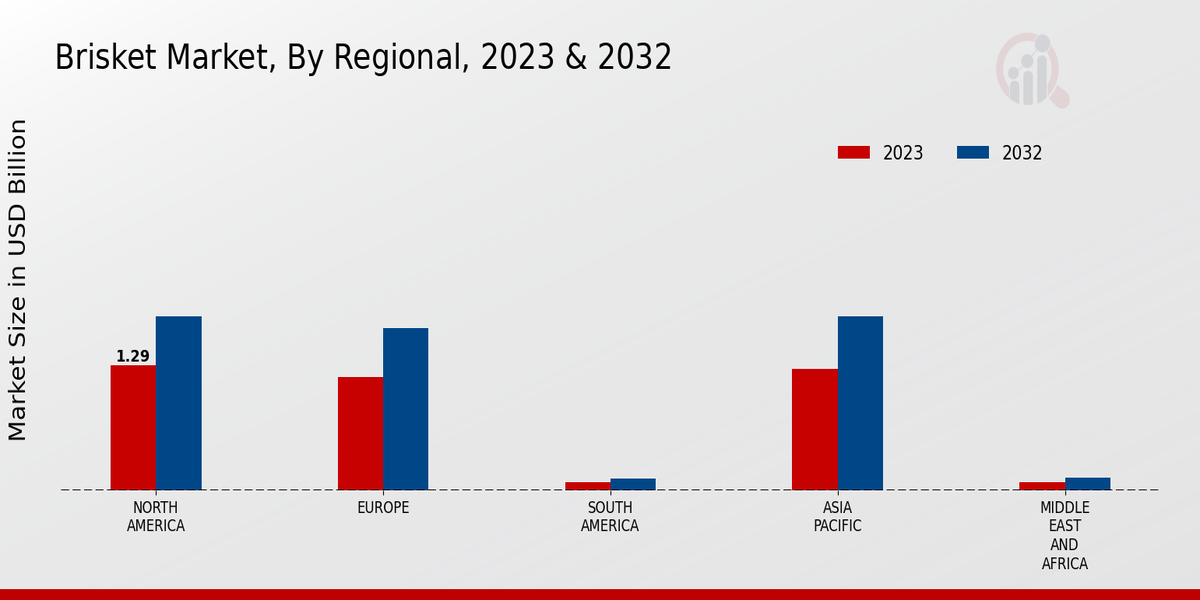Global Brisket Market Overview
Brisket Market Size was estimated at 3.71 (USD Billion) in 2022. The Brisket Industry is expected to grow from 3.86(USD Billion) in 2023 to 5.5 (USD Billion) by 2032. The Brisket Market CAGR (growth rate) is expected to be around 4.01% during the forecast period (2024 - 2032).

Source Primary Research, Secondary Research, MRFR Database and Analyst Review
Key Brisket Market Trends Highlighted
Key market drivers in the brisket market include the growing popularity of barbecue and smoked meats, increasing disposable income in emerging markets, and the rising demand for convenience foods. Opportunities to be explored or captured in the market include the development of new and innovative brisket products, the expansion into new distribution channels, and the targeting of specific consumer groups.
Recent trends in the brisket market include the increasing popularity of online ordering and delivery, the growing demand for premium and specialty briskets, and the development of sustainable and environmentally friendly production methods.
Brisket Market Drivers
Rising Demand for Convenient and Flavorful Meat Products
The main factors driving the brisket market are the growing popularity of convenience foods and the increasing demand for flavorful meat products. Owing to its rich taste and wide versatility, brisket appeals to more and more customers who seek an appropriate and quickly cooked meal. It is noteworthy that brisket can be cooked in a variety of ways, including smoking, grilling, and braising, and, thus, can be consumed by both amateur cooks and professional chefs.Moreover, brisket is becoming more popular due to its nutritional value since consumers are more likely to consider protein and iron content.
Expansion of the Food-service Industry
Emerging markets have led to increased opportunities for the brisket sector as the food service industry has expanded. To cater to the rise in demand for tasty and high-quality meat dishes, restaurants, cafes, and catering services are progressively adding brisket to their menus. Moreover, within the food service sector, barbecue or smoked meat concepts have seen an increase in popularity which has also helped grow demand for brisket.
Growing Health Consciousness and Preference for Natural Products
Brisket is a natural product associated with healthiness that capitalizes on this trend because consumers look for healthy and minimally processed foods. Nutritional value and absence of artificial ingredients are some of the attributes that endear it to health conscious customers. There is also a growing trend towards clean-label products and greater transparency in food production, which is boosting demand for ethically raised cattle producing sustainably sourced beef, of which brisket forms a vital component.
Brisket Market Segment Insights
Brisket Market Distribution Channel Insights
Distribution Channel The Brisket Market segmentation by distribution channel can be classified into retail, food service, and online. Among these channels, the retail segment dominated the market in 2023, accounting for approximately 55% of the Brisket Market revenue. This dominance can be attributed to the extensive distribution networks of supermarkets, hypermarkets, and convenience stores, which provide consumers with easy access to brisket products. The food service segment is anticipated to witness significant growth in the coming years, owing to the increasing popularity of dining out and the expansion of the food service industry.In 2023, the food service segment accounted for around 30% of the Brisket Market revenue. The growing demand for convenience and the expanding presence of quick-service restaurants, cafes, and food chains are driving the growth of this segment. The online segment is witnessing a steady rise, owing to the increasing penetration of e-commerce and the convenience it offers to consumers. The online segment is projected to register a CAGR of over 6% during the forecast period, reaching a market size of approximately USD 1.2 billion by 2032.The growth of this segment is attributed to the increasing adoption of online grocery shopping, the expansion of online marketplaces, and the growing popularity of meal-kit delivery services. Overall, the Brisket Market is expected to witness significant growth across all distribution channels in the coming years, driven by the rising demand for meat products, increasing disposable income, and evolving consumer preferences.

Source Primary Research, Secondary Research, MRFR Database and Analyst Review
Brisket Market Product Type Insights
Brisket Market is segmented by product type into fresh brisket, frozen brisket, smoked brisket and corned brisket. The fresh brisket segment will have the largest market share in 2023 because it is popularly used in home cooking and restaurants. The frozen brisket segment is expected to grow fast over the forecast period due to its convenience and extended shelf time. The smoked brisket segment is anticipated to contribute less share in the market but it will develop steadily over time. Corned Brisket Segment is expected to register a slow growth rate as compared to other segments.
The brisket market is slated to reach USD 3.86 billion in 2023. The growth of the market has been catalyzed by an increased demand for smoked and restaurant-quality beef from both commercial kitchens and individual consumers who also seem to take a keen interest in their foods' ingredients with a specific focus on smoked beef.
Brisket Market Application Insights
The Brisket Market is segmented on the basis of its application into Barbecue, Roasting, Smoking, Soups and stews. Among these segments, Barbecue holds the largest market share due to the increasing popularity of barbecue dishes around the world. In 2023, the Brisket Market revenue from the Barbecue segment was valued at USD 1.2 billion and is projected to reach USD 1.7 billion by 2032, exhibiting a CAGR of 4.3%. The Roasting segment is another significant contributor to the market, with a market size of USD 1.1 billion in 2023 and an anticipated CAGR of 4.1% over the forecast period.Smoking and Soups and stews segments are also expected to witness steady growth, with market revenues projected to reach USD 0.9 billion and USD 0.7 billion by 2032, respectively. The growing demand for ready-to-eat meals and convenience foods is driving the growth of these segments.
Brisket Market Regional Insights
The Brisket Market is segmented into North America, Europe, APAC, South America, and MEA. North America is the largest regional market, accounting for over 35% of the revenue in 2023. The region is expected to continue to dominate the market throughout the forecast period, driven by the increasing demand for brisket from the food service industry. Europe is the second-largest regional market, followed by APAC. The APAC region is expected to witness the fastest growth during the forecast period, owing to the rising disposable income and changing dietary habits of consumers.South America and MEA are relatively smaller markets, but they are expected to grow at a steady pace during the forecast period.

Source Primary Research, Secondary Research, MRFR Database and Analyst Review
Brisket Market Key Players And Competitive Insights
Major players in the Brisket Market are constantly striving to gain a competitive edge by investing in research and development, expanding their product offerings, and enhancing their distribution networks. The Brisket Market industry is characterized by a high level of competition, with several leading Brisket Market players vying for market share. These players are focused on developing innovative products, expanding their distribution channels, and implementing strategic partnerships to gain a competitive advantage.Leading Brisket Market players are actively involved in mergers and acquisitions to strengthen their market position and expand their geographical reach. The Brisket Market development is being driven by rising consumer demand for high-quality meat products, increasing urbanization, and the growing popularity of convenience foods. The market is also witnessing a trend towards premiumization, with consumers willing to pay more for high-quality brisket products.Cargill, a leading player in the Brisket Market, has a strong presence and a diversified product portfolio. The company is focused on providing a wide range of brisket products to meet the diverse needs of consumers. Cargill is also investing in research and development to develop innovative products and improve its production processes. The company has a strong distribution network that enables it to reach a wide range of customers.Tyson Foods, a major competitor in the Brisket Market, has a strong presence in the United States. The company is focused on providing high-quality brisket products to its customers. Tyson Foods is also investing in research and development to develop new products and improve its production processes. The company has a strong distribution network that enables it to reach a wide range of customers.
Key Companies in the Brisket Market Include
- JBS S.A.
- Cargill
- IBP Inc.
- OSI Group
- Smithfield Foods
- Marfrig Group
- Tyson Foods
- National Beef Packing Company
- Hormel Foods
- Seaboard Corporation
- Minerva Foods
- Sysco
- Keystone Foods
Brisket Market Industry Developments
The Brisket Market is projected to reach USD 5.5 billion by 2032, exhibiting a CAGR of 4.01% during the forecast period (2024-2032). Rising consumer demand for convenient and flavorful meat products, coupled with the growing popularity of barbecue and grilling, is driving market growth. Increasing disposable income and urbanization in emerging economies are further fueling demand. Key market players are focusing on product innovation and expansion into new markets to capitalize on growth opportunities. Recent developments include the launch of plant-based brisket alternatives and the development of new seasoning and marinade flavors. Sustainability and ethical concerns related to meat consumption are expected to influence market dynamics in the coming years.
Brisket Market Segmentation Insights
-
Brisket Market Distribution Channel Outlook
- Retail
- Food-service
- Online
-
Brisket Market Product Type Outlook
- Fresh Brisket
- Frozen Brisket
- Smoked Brisket
- Corned Brisket
-
Brisket Market Application Outlook
- Barbecue
- Roasting
- Smoking
- Soups and stews
-
Brisket Market Regional Outlook
-
North America
-
Europe
-
South America
-
Asia-Pacific
-
Middle East and Africa
| Report Attribute/Metric |
Details |
| Market Size 2022 |
3.71(USD Billion) |
| Market Size 2023 |
3.86(USD Billion) |
| Market Size 2032 |
5.5(USD Billion) |
| Compound Annual Growth Rate (CAGR) |
4.01% (2024 - 2032) |
| Report Coverage |
Revenue Forecast, Competitive Landscape, Growth Factors, and Trends |
| Base Year |
2023 |
| Market Forecast Period |
2024 - 2032 |
| Historical Data |
2019 - 2022 |
| Market Forecast Units |
USD Billion |
| Key Companies Profiled |
JBS S.A., Cargill, IBP Inc., OSI Group, Smithfield Foods, Marfrig Group, Tyson Foods, National Beef Packing Company, Hormel Foods, Seaboard Corporation, Minerva Foods, Sysco, Keystone Foods |
| Segments Covered |
Distribution Channel, Product Type, Application, Regional |
| Key Market Opportunities |
Rising demand for premium beef products Growing popularity of barbecue and grilling Expansion of fast casual and fine dining restaurants Increasing health consciousness Growth in ecommerce channels |
| Key Market Dynamics |
Rising beef consumption Growing popularity of barbecue Increasing availability of premium cuts Health-conscious consumers seeking leaner protein options Expanding retail distribution channels |
| Countries Covered |
North America, Europe, APAC, South America, MEA |
Frequently Asked Questions (FAQ) :
The Brisket Market size is expected to reach USD 5.5 billion by 2032, exhibiting a CAGR of 4.01% during the forecast period. This growth can be attributed to the increasing demand for protein-rich foods, coupled with the growing popularity of barbecue and smoked meat products.
North America is the largest market for Brisket, accounting for over 40% of the market share. Europe and Asia-Pacific are also significant markets, with growing demand for Brisket in these regions.
Brisket is primarily used in the food industry, with applications in various cuisines worldwide. It is commonly used in barbecue smoked meat dishes and as an ingredient in soups, stews, and sandwiches.
Major players in the Brisket Market include JBS, Tyson Foods, Cargill, and Smithfield Foods. These companies are investing in expanding their production capacities and distribution networks to meet the growing demand for Brisket.
The growing popularity of barbecue and smoked meat products, along with the increasing demand for protein-rich foods, are driving the growth of the Brisket Market. Additionally, the rise of e-commerce and home delivery services is making Brisket more accessible to consumers.
The Brisket Market faces challenges such as fluctuations in raw material prices, seasonality of demand, and competition from other meat products. Additionally, concerns about the environmental impact of meat production may pose challenges for the industry.
Opportunities for growth in the Brisket Market include the expansion of distribution channels, the development of new products and flavors, and the growing demand for premium and artisanal Brisket products.
The COVID-19 pandemic had a significant impact on the Brisket Market, with disruptions in supply chains and a decline in demand from restaurants and food-service establishments. However, the market is expected to recover as the pandemic subsides and consumer demand rebounds.
The Brisket Market is subject to various regulatory factors, including food safety regulations, animal welfare standards, and environmental regulations. These regulations can impact the production, processing, and distribution of Brisket.
The Brisket Market is expected to grow steadily over the forecast period, driven by the increasing demand for protein-rich foods and the growing popularity of barbecue and smoked meat products. The market is expected to reach a value of USD 5.5 billion by 2032, exhibiting a CAGR of 4.01%.





























